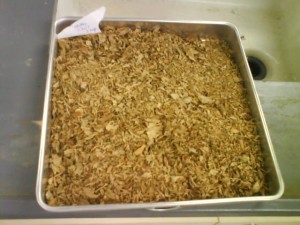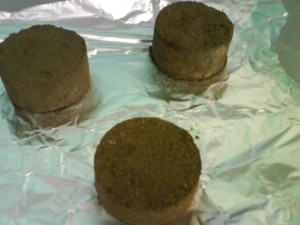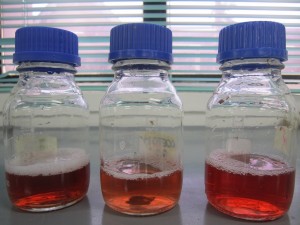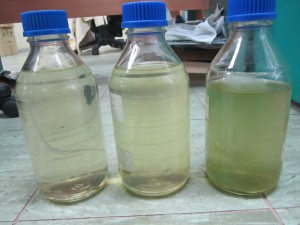Concept of Development (Bio-Briquetting and Bioethanol Fermentation)
A selected open ponding system or properly known as stabilization pond of domestic wastewater will be used for water hyacinth biomass cultivation. The growth of water hyacinth will entirely depend on the organic removal efficiency and nutrient present in the waste water medium. The selected local tropical species will be implemented at various operational and environmental conditions for optimization such as loading rate, growth period and detention time (or cultivation period).
Fresh water hyacinth (WH) with long stem will be collected, thoroughly washed to remove adhering dirt, chopped into small pieces (~1-2 cm), blended to small particles (~3-5 mm) and finally dried in solar drier or hot air oven at 105 °C for 6 hours. The dried material will be stored at room temperature until further used for firewood (briquette-biomass) and fermentation (bio-ethanol) production.
The bio-briquette will be produced with the help of briquetting machine with optimizing parameters like temperature, moisture, coal blending concentration, compression strength and the produced bio-briquettes were studied for green house gas emissions, calorific value, etc. The bio-ethanol production was carried out by hydrolyzing the pretreated biomass with the commercially available enzymes- cellulase, lignin peroxidase and xylanase. The lingo-cellulolytic method of ethanol production from water hyacinth performed by two different methods a) separate hydrolysis and fermentation (SHF) method ) simultaneous saccharification and fermentation (SSF) method. For SHF experiment, saccharification conditions will be carried out with different solid and enzyme loadings for 48 h at 50-70oC, 150 rpm in an orbital shaker. The sample was withdrawn at 0, 6, 24, and 48h respectively. All the flasks inoculated with 1 ml of 12-18 h grown starter culture of Saccharomyces cerevisiae and the same incubated for an additional 96 h at 30oC, 150 rpm in an orbital shaker. The samples were removed at 0, 6, 24, 48, 72, and 96h during fermentation and estimated for bio-ethanol production. For SSF experiments, saccharification and fermentation conditions was carried out simultaneously for different solid and enzyme loadings for 144h at 37oC, 150 rpm in an orbital shaker. An inoculum (1 ml) of a 12-18 h culture of Saccharomyces cerevisiae as starter culture was used for this study as similar to SHF method. The obtained ethanol will be evaluated using gas chromatography (GC) and the sugar characterization was carried out by high performance liquid chromatography (HPLC).
Bio-Briquette
Bioethanol
[PLEASE CONTACT FOR FURTHER INFO]
Pages: 1 2





